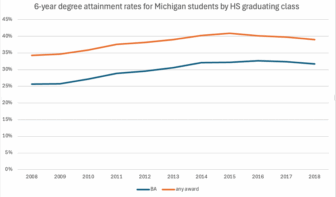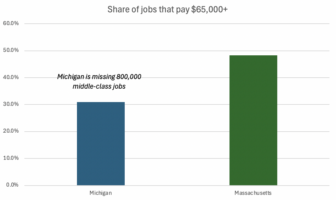In my last post we explored the alignment between state’s per capita income and the proportion of adults with a four year degree. Increasing four year degree attainment is a powerful lever in dealing with many of Michigan’s still substantial economic challenges. Here, in bullet form, is that case:
Michigan Today
- Michigan is now structurally one of the nation’s poorest states for the first time ever. 35th in per capita income and an even more troublesome 38th in per capita income when you exclude government transfer payments. Michigan’s per capita income is $40,740; $5,300 less than the national average. In 2009, in the depths of the Great Recession and a near bankrupt domestic auto industry, Michigan’s per capita income was $5,200 less than the national average. This is the first time that Michigan has been a low per capita income state with an expanding domestic auto industry.
- Michigan is in the bottom ten in both the proportion of those 16 and older working and 25-64 year olds working. (Even with an unemployment rate below the national average.)
- The Michigan Association of United Ways, in their ALICE report, found that forty percent of Michigan households struggle to meet basic needs: housing, child care, food, health care, and transportation. A majority of those households include a working adult.
- Like the nation, economic mobility in Michigan is declining. The basic American value of equal opportunity for all is rapidly disappearing for far too many Michiganders. Increasingly those born to lower income parents are lower income themselves.
A four year degree as the most powerful antidote
- For each of these four challenges four year degree attainment is one of––if not the––most powerful antidote.
- Except for a few states that rely on high commodity (mainly energy related) prices for their prosperity, the most prosperous states and metropolitan areas are those with a high proportion of adults with a four year degree or more. Of the top ten non-commodity-based states with the highest per capita income, eight are also in the the top ten in the proportion of adults with a four year degree or more. None is lower than 13th.
- The proportion of 25-64 year old Michiganders who work increases substantially with education attainment. 82 percent of those with a four year degree work, for those with some college or an associates degree its 71 percent, for those with a high school degree only its 62 percent, for those with less than a high school degree its 43 percent.
- As the ALICE report details the main reason households struggle to meet basic necessities is jobs that don’t pay enough. Increasingly good paying jobs require high skills. The median wage for Michiganders with graduate degree is $66,000, for those with a bachelors degree its $47,000, with some college or an associates degree its $31,000, with only a high school degree its $26,000 and with less than a high school degree its $19,000.
- Nationally the College Board reports that of those growing up in a bottom quintile household who do not obtain a four year degree nearly half (47%) are in the bottom quintile themselves. For those growing up in a bottom quintile household who do obtain a four year degree only ten percent remain in the bottom quintile themselves.
No Michigan does not have too many with four year degrees!






